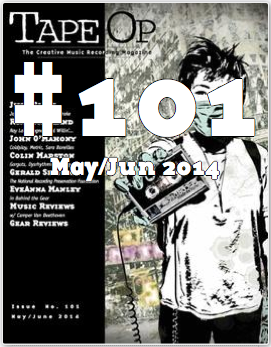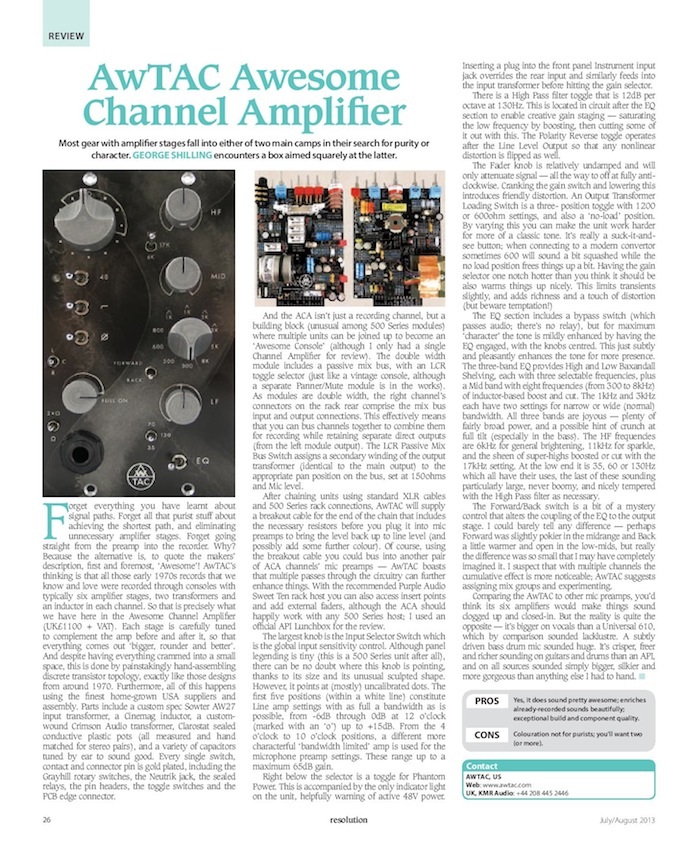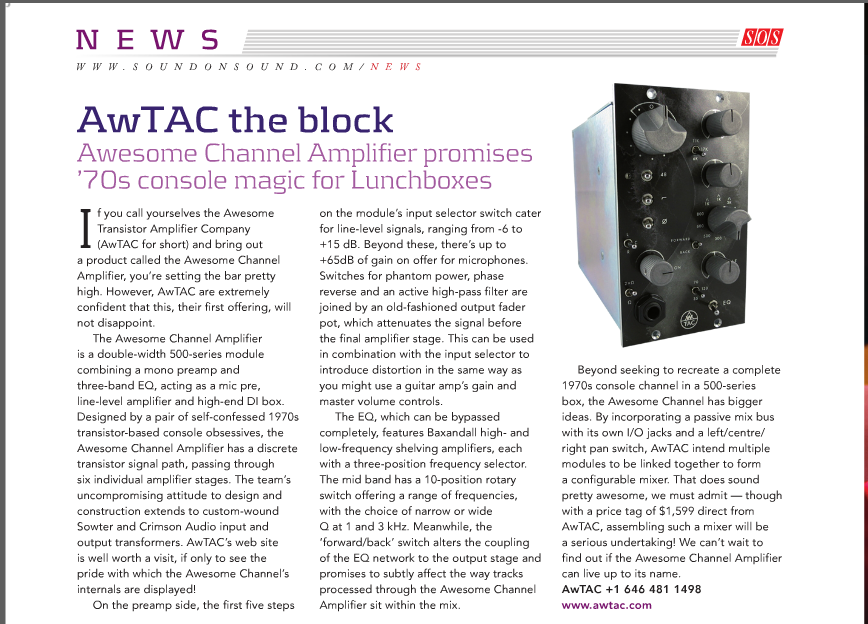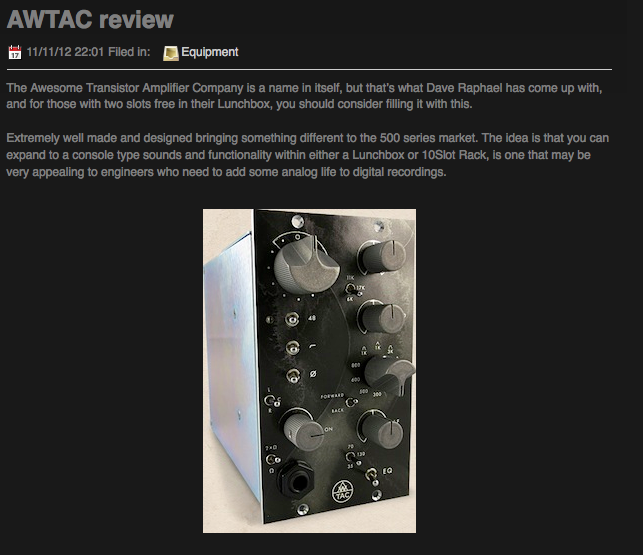Tape Op Magazine
Issue No. 101, May/Jun 2014
Reviewed by Chris Garges
AwTAC (Awesome Transistor Amplifier Company) of New York is quickly proving itself as a manufacturer with high standards. Since the introduction of its Channel Amplifier [Tape Op #93] three years ago and their Panner module (which adds a stereo- panning summing bus to the L/C/R bus in the Channel Amplifier, or works as a standalone panning/summing bus to turn select 500-series racks into summing mixers, one channel at a time), the guys at AwTAC have been busy applying their “no sonic compromises” design philosophy to their new 500- series format Channel Compressor.
The single-space unit is a mono FET compressor with seemingly-normal front-panel controls. Continuously variable knobs are provided for Reduction, Release, and Output, as are switches for bypass, auto-release, and detector high-pass filter. A three-position attack-speed switch and unique Drive and Blend knobs round out the controls. The compressor behaves in a soft-knee fashion, easing from a 1.5:1 ratio up to 10:1 (and at times, beyond). There is also an eight-segment orange LED meter for indicating gain reduction with an extremely useful range of -0.5 dB to -15 dB.
The Channel Compressor’s Drive knob is essentially an input and distortion control that drives the input circuit, largely affecting the sound of the unit, making for really great tonal options. Drive can impart useful “grit” – from almost nothing to a very aggressive and very cool sound – that is somewhat independent of the onset of compression. The Reduction knob increases gain reduction (compression) and functions as one would expect, while offering a large range of subtle control in the lower settings. Like the EQ settings on AwTAC’s Channel Amplifier, Reduction can be turned all the way up (for maximum gain reduction) without the resultant sound “folding” at the most extreme settings. The Channel Compressor’s detector HPF seems to operate at a much higher frequency than similar filters in other compressors, and its impact is not at all subtle. Engaging the filter makes for a much smoother compressor action with all types of signals. Same goes for the auto-release switch; when it’s enabled, the compressor action becomes smoother and more musical. This, coupled with the detector HPF, makes the Channel Compressor beautifully transparent in its compressor action, a feat not easily achieved with other units – even when the Reduction control is maximized. In this case, the Attack switch gives you a few options for shaping the aggression, but generally speaking, this setting will level a vocal, a bass, or a bright, spanky guitar in a way that few other compressors can.
But have no fear, compression junkies! Leave the detector unfiltered, speed up the release time, dial in some Drive, and you have a wonderfully aggressive “grit machine.” Vocals can become much more energetic, and drums and bass can sit in a semi-fuzzy puddle in just the right place in a mix with these kinds of settings.
Another interesting development courtesy of the AwTAC team is the way the Blend and Output controls work. The Output control is exactly that – an output level for the compressor. While the Blend control is an output level control for the dry, uncompressed output fed from a discrete amp in parallel with the compressor circuit. This way, parallel compression is achieved the same way it would be with two faders on a console. There is truly a blend of wet and dry signals that react the way they would on a console – and not just a sweepable balance between the two, as is found in most other units with a similar feature. Output and Blend are extremely interactive, and because of this, setting the two knobs can take a little getting used to, but the resulting compression behavior is fantastic.
A quick word about the LED metering too – there’s a half dB measurement on the meters. I find this remarkably useful. There’s a famous compressor with an LED meter that starts at -1 dB, and for years, I’ve sworn that I can hear that compressor working before it actually meters 1 dB of reduction. Kudos to AwTAC for taking this into consideration. Another interesting feature of the AwTAC meter is a slight “flickering” of the meters in the compressor action, most noticeable with a lot of gain reduction happening. I can’t think of any real, practical use for this, but it just seems kind of cool and amusing to me. One more thing that just kind of reminds me that music is happening.
The sound of the Channel Compressor is absolutely gorgeous. It retains a beautiful, almost “woody” kind of tone that I appreciate from equipment like the revered Nyquist converters in the iZ Technology RADAR [Tape Op #56], for example, or much of Manley’s highly-regarded tube line. Hi-fi, but extremely pleasant, musical, and not at all harsh. The sound of the unit is apparent, but it’s not something I would take out of the circuit at all. In fact, I want 24 of them wired right up to the output of my converters!
In terms of compressor behavior, this has got to be one of the most versatile dynamics processors I’ve ever used. While low action, subtle compression can be effective with the AwTAC, this thing really seems happy doing lots of gain reduction. But doing lots of gain reduction with the Channel Compressor isn’t the same as doing lots of gain reduction with most other units. The Channel Compressor seems to have a wide berth, and it’s hard to make this thing completely cave. I’m not one to constantly blow up everything I run through a compressor, but this compressor is perfectly happy doing its job at a steady pace of 6-15 dB of gain reduction without sounding like it’s destroying the source. Of course, whacky time constant and Drive control settings can get it there, but careful use of the detector filter and auto-release make this thing a beautiful addition to the realm of available 500-series compressors, the likes of which I have not yet heard.
All in all, the Channel Compressor is easily one of my favorite compressors – ever. It has everything I love about FET compressors and none of the things I dislike about them. And it has everything I love about optical compressors and none of the things I dislike about them. It has the in-your-face speed and texture of an 1176 or an ADR Compex; the easy, forward-pushing placement of an LA-2A or LA-3A; and the dynamic control of classic broadcast vari-mu and FET limiters like the Altec 436C and the CBS Volumax – all with a very pleasant and useful tone and a nice set of features that make this an extremely versatile and flexible unit. As exemplified in other AwTAC products, the build quality of the Channel Compressor is solid. The unit has a two-year warranty, and it’s built of almost entirely American-sourced parts by a small company in New York.
($1099 direct; www.awtac.com)
Tape Op Magazine
Issue No. 93, Jan/Feb 2013
Reviewed by Chris Garges
Dave Raphael is one of the smartest guys I know. He’s a terrific recording engineer, a great photographer, a technically-knowledgeable individual, and he has absolutely astounding ears, so when he told me several years ago that he and Jens Jungkurth were working on building an equalizer, I was curious about it. Over that period of time, the project evolved into the Awesome Transistor Amplifier Company (AwTAC) Awesome Channel Amplifier, a discrete, hand-wired, double-wide 500-series mic preamp, line amp, DI, and EQ with a mix bus and several other unique features. AwTAC took three production models to preview at the 2011 Fall AES show and then sent them to me. I’ve been the first person outside of the company to use them in a professional recording capacity, and they’ve been in use in some form or fashion on almost every single session I’ve done over the past year. According to the AwTAC website, “When you call two and a half years of development on a product ‘Awesome Channel Amplifier,’ it had better be just that.” I concur.
The AwTAC Channel Amplifier is a heavy piece of machinery. It’s built solidly in New York City of almost entirely US- sourced high-quality parts, some of which have been specifically manufactured for AwTAC. The front panel artwork looks quite serious, with a unique design that’s been anodized into the metal (not silk-screened), so it should stand up to “a short eternity of human finger rubbing,” and the macho, custom turned knobs round out the unit’s solid appearance. Taken care of properly, these things will likely outlast their original owners.
The sonic and working aesthetic of the Channel Amplifier is clearly based on recording technology of the early 1970s. Audio in the unit passes through between three and seven discrete amplifiers (depending on what’s engaged), two transformers, and an inductor. Each audio stage is individually designed to complement what comes before and after it, and each one sounds large and expansive. Simply engaging the EQ (set flat) sends the signal through three additional amplifiers, increasing the tonal “color” options. This is essentially how complete consoles from that era operated – with each stage designed as an individual component but meant to work within an entire “system.” When people say that an individual API 312 module doesn’t sound the same as it did in an original console, this is usually why.
Although there is certainly a general ’70s vibe to the unit, the Channel Amplifier is pretty much unlike anything else I’ve ever used from that period or otherwise. It can have an aggressive, API-like character and frequency response that’s useful on anything, but without the hard-sounding midrange. When driven with more gain, the fuzzy “out- front” character is somewhat similar to a Langevin AM16 [Tape Op #33] (especially with the Image switch set to Forward – more on that in a minute), but the accentuated harmonic content and apparent compression seem similar to a Telefunken V72 to me (especially on distorted electric guitar amps). The inductor-based midrange band on the EQ reminds me of the “large” size that you get from plugging into a Sphere EQ, while the high-frequency band seems to be reminiscent of many of the classic British equalizers of the period. Boost the bottom, and you start wandering into vintage Neve territory, but boost while engaging the gentle high-pass filter, and the bottom clears up in a really nicely- controlled way, allowing for an astounding array of low- frequency tone-shaping possibilities.
As a standalone amplifier, the unit sounds great. The twelve- position input-gain knob is marked with line-level unity at 12 noon, and it switches from line to mic amp at 4 o’clock. An output transformer loading switch allows for additional tonal options that are varying degrees of different and/or noticeable, depending on the source material. The line amp on the unit is a really nice surprise and sounds fantastic when used as the sole amplifier on most high-output microphones. I’ve been using the line amp on different instruments in a mix with great results, too. Soon after I received the units, I sent a direct bass signal through one of them with the line amp running “right at the edge” of breaking up, and the result was amazing. The recorded DI signal sounded as if I’d used a mic on an amp and a bass with extremely articulate and much newer strings. There was a “shimmery” clarity that the bass had been lacking,
and the Channel Amplifier helped situate the bass perfectly in this “big rock mix” without using any drastic EQ or outboard compression. The Channel Amplifier’s mic preamp has a semi- aggressive character that, when run hot, accentuates harmonic complexities. For me, this translates into musicality, much the way that symphonic percussionists are taught to accentuate harmonics with triangle playing technique. I find it tempting to run the mic preamp right at the edge at all times, but the large- ish steps in the gain range make it so that one little surprise in level can overdrive the units easily. The EQ circuit is also highly interactive in the series of gain stages in the unit, so it’s a good idea to reassess the AwTAC’s other levels while applying EQ (which is usually a good idea under any circumstances). It’s a great-sounding distortion too, but one that might make you think twice about being cavalier with gain.
The three-band EQ is a unique beast. Features-wise, it utilizes a Baxandall-type high and low shelf with three available frequencies each, and an inductor-based mid band with ten available frequency- selection points. Sonically, the additional amplifier stages open up the Channel Amplifier in a different way. The guys at AwTAC spent a great deal of time experimenting with the EQ during the design and testing process, until they found a collection of frequencies they thought sounded really terrific. Several months went by before they ever bothered to measure what those frequencies were. (In fact, they originally considered marking the front panel with a series of cryptic symbols for each frequency.) So, the way the EQ works is based completely and totally, 100% on “sound” – and nothing else. As a result, the AwTAC features two 1 kHz and two 3 kHz points on the mid band, each labeled as “wide” and “narrow.” Generally speaking, the bands on these frequencies are all fairly wide. This is not intended to be a surgical-type equalizer at all, but it makes for an extremely effective tone-shaping tool. It’s worth noting that these EQs were meant to be boosted or cut to their full potential, and turning any of those knobs pretty much all the way in either direction works well without falling apart sonically. It just sounds good. I also have no idea how they were able to get such a smooth and completely useful musical sound out of the 1 kHz selection. I’m generally frightened to death of 1k, but have found myself frequently recording tracks with the Channel Amplifier’s wide 1k boosted by a considerable amount. It does something that no other equalizer I’ve ever used has been capable of doing in that range. With the uniqueness of the boost and cut shapes (which are different) and the overlapping bands, two Channel Amplifiers equalizing a source in series is just CRAZY.
Totally unique to the Channel Amplifier is the addition of an Image switch in the EQ circuit. This magic little switch provides additional sonic choice to the general tone of the EQ. The options are a full-range, pleasant sound that sits nicely within a mix, or a slightly more assertive sound that helps the signal “jump” to the front. In practice, one might record basic rhythm guitar tracks with Image set to Back, and then cut solos and single note lines with the switch set to Forward. At this point, the quieter single-note stuff steps out from the other guitar sounds without making any changes to guitar, amp, mic, preamp, or EQ settings. Cut lead vocals with the switch in Forward, background vocals with it Back. Make kick and snare drums jump out from the rest of the drum kit. This is a subtle but extremely useful and completely unique feature of the Awesome EQ.
As a fan of recording air movement, I don’t use DIs all that often, but on occasion, circumstances require me to do so. The front-panel DI on the Channel Amplifier sounds fantastic on all the usual sources – bass guitar, keyboards, drum machines, etc. At the suggestion of the AwTAC website, I decided to make my first foray into direct pedal steel recording when one of my favorite musicians, Bob Barone, came to Old House Studio to play on a project. I decided to record pedal steel in the control room via the Channel Amplifier’s DI with the idea of being able to re-amp the steel if I wasn’t completely satisfied with the tone. I was shocked and amazed to hear how well the Awesome DI performed in this instance, and it just might have made me a convert to this pedal steel overdubbing method.
Also unique to the Channel Amplifier is a left/center/right-switchable passive mix bus. This allows for chaining several Awesomes together in a rack or in a console to allow for bussing of signals using simple XLR cables and a special splitter cable (supplied by AwTAC) at the end of the passive signal path. With something as simple as a pair of units, two mics can be summed to a single track. With several units, they can be used as a very good sounding summing system. Since it’s a passive summing system, you can plug the output of the last unit into your choice of mic preamp (an API is my favorite pairing with the AwTAC so far) for a variety of makeup-gain options. The mix bus alone has an amazingly immense sound to it. I used the Channel Amplifiers for some tonal shaping of a live 2-track editing project for a client, and just for kicks, I decided to hear how the fairly narrow- sounding recording would fare through the Channel Amplifier’s mix bus. Sending a stereo signal through the mix bus makes what comes out the other end noticeably wider and bigger-sounding, but without any phase silliness. The end result was a big improvement that far surpassed my expectations. It’s frightening to think of what an entire console made of Awesome would sound like.
For whatever its worth, I was able to compare the sound of the AwTACs in three different 500- series racks: a Brent Averill lunchbox, an 11-space Old School Audio rack, and a Purple Audio Sweet Ten. While the Sweet Ten sounded best to my ears, the AwTAC sounded amazing in all three racks, and it doesn’t seem like there are any issues with current draw in any normal 500-series racks, even with a completely full rack. (The Purple and OSA racks had no issue powering four Channel Amplifiers and two Buzz Elixir preamps [Tape Op #65], which draw a lot of current.)
I am completely and totally in love with the AwTAC Channel Amplifiers. I currently have two in my personal collection and am trying to figure out how to pull off buying at least two more. They stack up every bit as well as, if not better than, the other preamps and EQs I have at my disposal, which includes a large variety of all the usual suspects. With initial factory-direct pricing of $1599, the AwTACs are a steal. Pairing any other great high-quality mic preamp and equalizer in a 500- series format is likely to cost more than that – without supplying any of the Channel Amplifier’s completely unique and useful features. I’m glad AwTAC is offering a piece of equipment like this in an age of questionable quality and longevity. ($1599 direct; www.awtac.com)
-Chris Garges www.chrisgarges.com
Music Tech Magazine
Issue No. 122, May 2013
Reviewed by John Pickford
A 9/10 review in the May 2013 issue of Music Tech earned us a Choice Award. Have a peek at what John Pickford had to say!
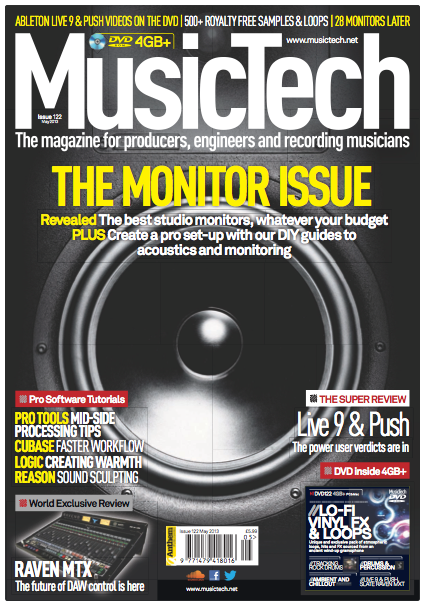


Resolution Magazine
July/August 2013
Reviewed by George Shilling
click image for .pdf
Sound On Sound Magazine
October 2012
Sonic Scoop
Justin Colletti wrote a nice overview on Sonic Scoop
Nick Mitchell
Nick Mitchell shares some thoughts on Channel Amps on his blog:
